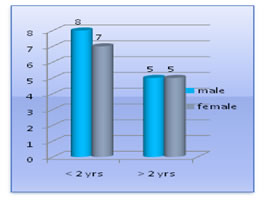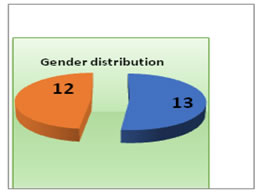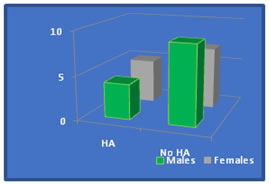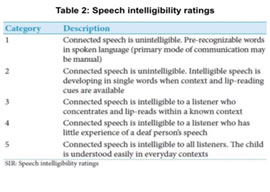Official Journals By StatPerson Publication
|
Table of Content - Volume 10 Issue 2 - May 2019
Cochlear implants in our institute: A retrospective study
Deep Jyoti1, Aditiya Saraf2*, Sunil Kotwal3, Vinay Bharti4
Department of ENT and Head and Neck Surgery, SMGS Hospital, Government Medical College, Jammu, Jammu and Kashmir, INDIA. Email: rksaraf56@gmail.com
Abstract Aims and Objectives: The aim of our study is to evaluate the outcome of cochlear implants done in our institute. Material and methods: It is a retrospective study of 25 patients with severe to profound sensorineural hearing loss who underwent the cochlear implantation in the Department of Otorhinolaryngology and Head and Neck surgery, GMC Jammu. All the cochlear implants were done by Veria’s technique. In this technique, instead of doing posterior tympanotomy, a canal is drilled in postero-superior part of the external auditory canal. Cochlear implant functioning was checked on the table by neural response telemetry(NRT).Post-operatively patients were given antibiotics and decongestants. Devices were switched on between 3- 4 weeks. All the candidates were called for regular follow up for upto a period of1 year. Results: Out of 25 candidates, 6 candidates got excellent hearing results, 9 got good hearing results and 8 got average hearing results, results being graded as excellent, good and average on CAP AND SIR scales. Conclusion: Cochlear implants are the treatment of choice for auditory rehabilitation of patients with sensorineural deafness. Children can achieve a near to normal speech and language development, provided their deafness is detected early after onset and implantation is performed quickly thereafter. Key Word: Cochlear implants, Veria
INTRODUCTION Hearing ability is one of the five primary senses. Impairment of hearing causes prevalent deficit in all other sensory organs. Though it causes no mortality, there is an enormous impact on the social, Educational and economic wellbeing of hearing-impaired person. Approximately 5-6 children per 1000 born have hearing impairment. India has 6.3% of its population suffering from hearing loss8. Government of India was not paying much heed to this mammoth size problem. However the National programme for prevention and control of deafness (NPPCD) has revived the interest in this widespread public health problem. This programme was launched on pilot basis in 2006-07 with the purpose of early identification, diagnosis and treatment of ear problems. Cochlear implants have also been covered under schemes of Govt. of India like RBSK (Rashtriya Bal Swasthya Karyakram) and ADIP (Assistance to Disabled Persons for Purchase/Fitting of Aids). We have performed 25 cochlear implants in the dept. of ENT, GMC Jammu Cochlear Implant: A cochlear implant works by producing meaningful electrical stimulation of the auditory nerve where degeneration of hair cells in cochlea has progressed to a point such that amplification provided by hearing aids is no longer effective. A cochlear implant has an external and internal component- External component consists of an external speech processor and a transmitter; Internal component is surgically implanted and comprises the receiver package with an electrode array. Sound is picked up by the microphone in the speech processor. The speech processor analyses and codes sound into electrical impulses. The electrical impulses are sent from the processor to the transmitting coil which in turn sends the signal to surgically implanted receiver. The receiver decodes the signal and transmits it to electrode array, which has been placed in scala tympani of cochlea, stimulates spiral ganglion cells. The auditory nerve is thus stimulated and sends these electrical impulses to brain, which is finally interpreted as sound.9 -Pre-requisites for cochlear implantation9- 1-Bilateral severe to profound SNHL 2-Little or no benefit from hearing aids 3-Good family support MATERIAL AND METHODS Pre-operative assessment:History related to: cause, duration of hearing loss, hearing aid used, communication used by candidate, level of language, developmental delay, major health problems, any past history of ear infections, ear surgery, otitis media with effusion etc. was taken.Examinations- general physical, local ENT examination were done; or any abnormal behaviour was checked. -Audiological tests were done- In case of adults, PTA and Impedance were done. In case of children, BERA and OAE were done. Electrophysiological tests like ASSR were also carried out. -Radiological investigations –HRCT temporal bone, MRI brain with 3D reconstruction of cochlea and Chest Xray were done. -Blood investigations –CBC, RFT, LFT, TORCH, Serology were done -IQ (Intelligence quotient) and DQ (developmental quotient) were done -Immunisation against hemophilus influenza and pneumococcus were done Counselling: It is a very important step in the process of cochlear implantation.Candidate and their parents must understand the process of habilitation after cochlear implant. A strong support system comprising family and teachers is necessary so that understandable speech develops. All the cochlear implants were done by Veria’s technique. In this technique, instead of doing posterior tympanotomy, a canal is drilled in postero-superior part of the external auditory canal1.Cochlear implant functioning was checked on the table by neural response telemetry(NRT).Post-operatively patients were given antibiotics and decongestants.Devices were switched on between 3-4 weeks. All the candidates were called for regular follow up for upto a period of1 year.
RESULTS 25 candidates were implanted the cochlear implant with age ranging from 18 months to 25 yrs. Figure 1: 13 candidates were male while 12 were female candidates. Prior to the cochlear implantation, 9 candidates were using hearing aids while 16 candidates had never used any hearing aid. There were no intra-operative complication in any of the cochlear implantee There were no post-operative complications as well expect one patient who developed facial nerve weakness on 5th post-operative day which was present till the day of discharge. Post-op follow up: A simplified follow up schedule was undertaken: -Implantees were called for three weekly follow-ups -Then again implantees were called after every three months -Parents actively participate in the habilitation programme so that child develops speech, native language and communicating skills. The family continues the process of supporting the linguistic skill development of child. Progress is reviewed at 1 year post cochlear implant and grouped as excellent, good, average, as per CAP and SIR SCALE7
DISCUSSION Hearing in profoundly deaf people can be helped by inserting implant in inner ear to stimulate cochlear nerve. Cochlear implantation is a relatively new procedure, which has already had significant impact on the lives of many profoundly deaf children and adults. The overall hearing experience, deafness duration and age at onset of deafness are important issues to consider prior to cochlear implant. There are two techniques- suprameatal and veria technique. Theveria technique for cochlear implantation was used in our study, which is a non mastoidectomy technique which is done through endaural route for the cochleostomy with a transcanal tunnel drilled in posterior canal wall1.Suprameatal technique eliminates need for mastoidectomy and posterior tympanotomy, introduces electrode into cochlea via suprameatal region. In our study, 25 candidates were implanted the cochlear implant with age ranging from 18 months to 25 yrs. 13 candidates were male while 12 were female candidates. Prior to the cochlear implantation, 9 candidates were using hearing aids while 16 candidates had never used any hearing aid. Complication rate in our study was low. There were no intra-operative complication in any of the cochlear implantee. There were no post-operative complications as well expect one patient who developed facial nerve weakness on 5th post-operative day which was present till the day of discharge. 6 candidates got excellent hearing results, 9 got good hearing results and 8 got average hearing results, results being graded as excellent, good and average on CAP AND SIR scales. CAP was used to measure the speech perception performance of implanted children, comprising of a scale ranging from “no awareness of environmental sounds” to “can use the telephone with a familiar talker”7 SIR was used to measure the speech intelligibility of the implanted children by quantifying their everyday spontaneous speech., comprising of five performance categories ranging from “pre-recognizable words in spoken language” to “connected speech is intelligible to all listeners” 7 Auditory skill outcomes were found to be better in the candidates who were below age-group of 2years and were already using hearing aids before cochlear implantation.
CONCLUSION Cochlear implants are the treatment of choice for auditory rehabilitation of patients with sensory deafness. Children can achieve a near normal speech and language development provided their deafness is detected early after onset and implantation is performed quickly thereafter. The important issues to consider are the overall hearing experience, deafness duration and the age at onset of deafness. Careful counselling and family support is necessary.
REFERENCES
|
|
 Home
Home





